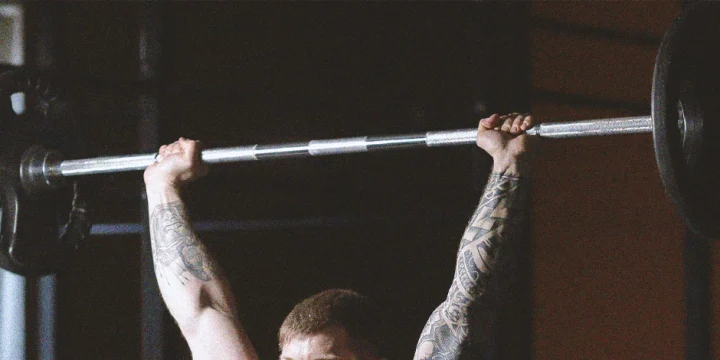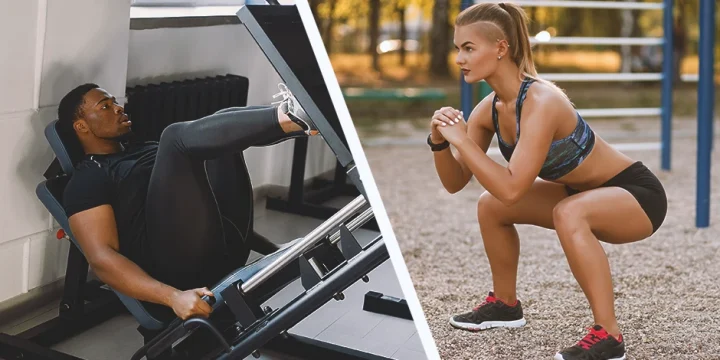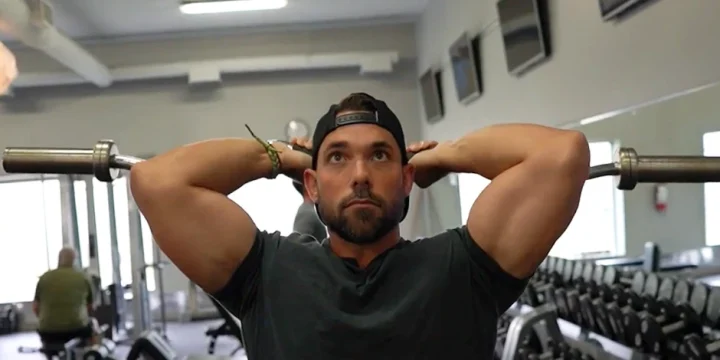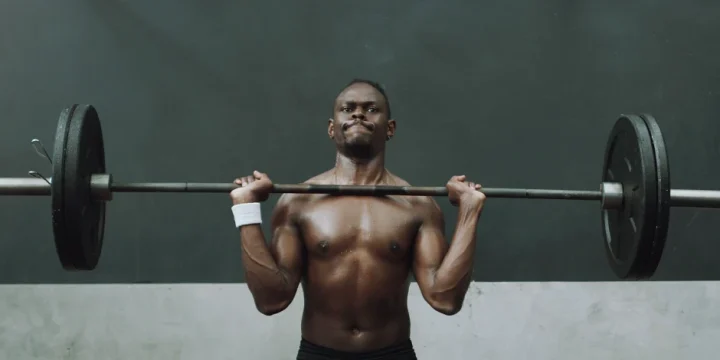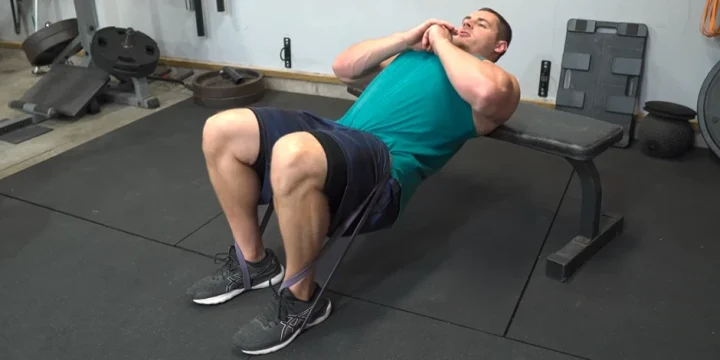As a certified personal trainer, I often recommend that bodybuilders use more resistance bands for different exercises.
And the one that usually raises eyebrows and questions is the banded dumbbell bench press.
There are some excellent benefits to this exercise as long as you do it with proper form and the right setup for the bands.
So, I got some of my clients to help and test a few different setups and approaches to come up with the best and safest way.
Let me show you what’s involved.
Quick Summary
- To perform banded dumbbell bench presses, loop a resistance band under the bench and attach each end to a dumbbell, then execute the bench press with the added resistance of the band.
- This exercise variation not only targets the primary muscles involved in bench pressing but also engages stabilizing muscles for improved balance and coordination.
- Research from the National Center for Biotechnology Information indicates no significant difference in effectiveness between elastic and conventional resistance training for muscular strength, with a standardized mean difference of -0.011 (95% CI: -0.40 to 0.19, p = 0.48) for upper limbs and 0.09 (95% CI: -0.18 to 0.35, p = 0.52) for lower limbs.
- Drawing from my extensive experience in the field, I can confidently say that the integration of resistance bands in traditional exercises like the dumbbell bench press offers a dynamic and effective approach to strength training.
How To Do Banded Dumbbell Bench Press

Let me give you step-by-step instructions on how to do banded dumbbell bench press exercises.
The first couple of steps are the most important ones:
- Get a flat bench at the gym and place a dumbbell on each side on the ground.
- Attach the looped end of a band around the center of the dumbbell handle.
- Make sure that the center of the band is directly below the bench to ensure each side has the same level of tension.
- Grab hold of the dumbbells and lay down on the bench holding the free weights close to your chest.
- Slowly push up the dumbbells and feel how the strain of the weight and band gradually increases as you get closer to the top.
- Hold the top position for one second and then slowly lower the weights back down again.
- The shorter or thicker the band is, the more strain you’ll add, and the better the benefits will be.
What Are The Benefits?

The benefits are improved coordination and balance, increased muscle activation, and a unique tension curve.
Let me show you what I mean.
Improved Coordination And Balance
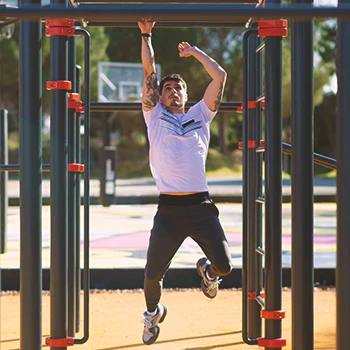
In my experience with a regular dumbbell bench press, you already have to be more conscious of your coordination to raise both weights at the same time and the same speed.
According to the NASM website, when you add a band into the mix, then that need for coordination and balance becomes more important [1].
That slight imbalance can then help to further activate more secondary muscles to help stabilize the movement.
Increased Muscle Activation
From my personal training experience, beginners quickly notice an increase in muscle strain as the tension from the resistance bands intensifies. This gradual increase, which I often point out during sessions, is key to maximizing muscle activation.
This can then help to achieve stronger muscle activation in more areas [2].
"Bands are a great tool for activation because they force us to move in a very controlled manner, which helps embed proper technique."
- Lauren Bedosky, Health & Fitness Journalist at Livestrong.com
Read Also: Comparing Resistance Bands and Dumbbells for Workouts
Unique Tension Curve
When you exercise with bands, you don’t get a full load of resistance from the start.
According to one of the studies from the National Center for Biotechnology Information website, you have a tension curve that gradually increases during the eccentric movement and then decreases during the concentric movement [3].
Intermediate Variation

Once you learn how to do banded dumbbell bench press exercises, it’s time to add a bit of variation and step things up.
What I have in mind here is to switch from workouts with dumbbells to using a barbell instead. The idea is the same, but this time you're attaching the looped end behind the plates on each side of the bar.
The result is similar, but you should find that you can gradually increase the number of weight plates in your workouts and train your shoulders and pecs in a more intense way.
One of the studies from the National Center for Biotechnology Information website that evaluated effects of training with elastic resistance versus conventional resistance on muscular strength concluded the following:
There was no significant difference in effectiveness between the analyzed methods for increasing muscular strength in both upper limbs (with a standardized mean difference of -0.011 and a 95% confidence interval ranging from -0.40 to 0.19, p = 0.48) and lower limbs (standardized mean difference of 0.09, 95% confidence interval from -0.18 to 0.35, p = 0.52) [4].
Learn More: A Guide to Choosing Between Barbells vs Dumbbells
FAQs
What Is The Point Of Banded Bench Press?
The point of a banded bench press is to introduce gradually increasing resistance. As your hands get to the top of the movement, the strain will increase, and this can help with better muscle activation.
How Much Weight Does A Resistance Band Add To Bench Presses?
A resistance band can add up to 20% or more weight to bench presses. It all depends on the thickness and starting tension, and it’s something you should experiment with.
How Does Biomechanical Analysis Affect Muscle Engagement in Banded Dumbbell Bench Press?
Biomechanical analysis affects muscle engagement in the banded dumbbell bench press by altering the resistance curve, which leads to increased muscle activation throughout the entire range of motion. This variation ensures more consistent tension on the muscles, enhancing both strength and hypertrophy.
What Are the Specific Benefits of Banded Dumbbell Bench Press for Rehabilitation and Injury Prevention?
The specific benefits of the banded dumbbell bench press for rehabilitation and injury prevention include reduced joint stress and improved muscle activation patterns. These aspects make it an ideal exercise for those recovering from injuries or looking to prevent them.
How Does the Banded Dumbbell Bench Press Compare with Other Resistance Band Exercises?
The banded dumbbell bench press compares with other resistance band exercises by offering a unique combination of stability and variable resistance, which is not as prevalent in other band exercises. This makes it particularly effective for targeting the chest and triceps muscles dynamically.
What Are Effective Progression and Variation Strategies for Banded Dumbbell Bench Press?
Effective progression and variation strategies for the banded dumbbell bench press include altering band thickness for varied resistance and adjusting the bench angle to target different parts of the chest. These modifications can help overcome plateaus and continuously challenge the muscles.
References:
- https://blog.nasm.org/how-effective-are-resistance-bands
- https://www.livestrong.com/article/13722373-activation-exercises-strength-training/
- https://www.ncbi.nlm.nih.gov/pmc/articles/PMC3899915
- https://www.ncbi.nlm.nih.gov/pmc/articles/PMC6383082/
About The Author
You May Also Like
